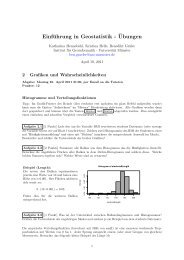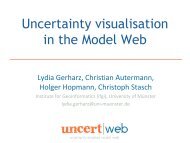Spatio-temporal analysis of point patterns and lattice data
Spatio-temporal analysis of point patterns and lattice data
Spatio-temporal analysis of point patterns and lattice data
You also want an ePaper? Increase the reach of your titles
YUMPU automatically turns print PDFs into web optimized ePapers that Google loves.
<strong>Spatio</strong>-<strong>temporal</strong> <strong>analysis</strong> <strong>of</strong> <strong>point</strong> <strong>patterns</strong> <strong>and</strong> <strong>lattice</strong><br />
<strong>data</strong><br />
V. Gómez-Rubio<br />
Department <strong>of</strong> Mathematics<br />
School <strong>of</strong> Industrial Engineering<br />
U. <strong>of</strong> Castilla-La Mancha, Spain<br />
Münster, 21 March 2011<br />
V. Gómez-Rubio (UCLM) <strong>Spatio</strong>-Temporal Analysis 1 / 22
Talk Outline<br />
Point Patterns<br />
Tornado Data<br />
Spatial Models<br />
<strong>Spatio</strong>-Temporal Models<br />
<strong>Spatio</strong>-Temporal Analysis<br />
Lattice Data<br />
Link to Point Patterns<br />
Spatial Models<br />
<strong>Spatio</strong>-Temporal Models <strong>and</strong> Analysis<br />
V. Gómez-Rubio (UCLM) <strong>Spatio</strong>-Temporal Analysis 2 / 22
Tornado Data 1950-2009<br />
We will use some Tornado <strong>data</strong><br />
to show the <strong>analysis</strong> <strong>of</strong> <strong>point</strong><br />
<strong>patterns</strong><br />
These <strong>data</strong> have been obtained<br />
from the Storm Prediction<br />
Center a<br />
Tornado <strong>data</strong> from 1950 until<br />
2009 are available<br />
In addition to the coordinates,<br />
we have a wealth <strong>of</strong> related<br />
information for each tornado<br />
a http://www.spc.noaa.gov/wcm/index.html#<strong>data</strong>
Location <strong>of</strong> Tornados<br />
54123 tornados recorded in the 1950-2009 period<br />
53217 occurred in the Continental States (without Alaska)<br />
The starting <strong>point</strong> <strong>of</strong> the tornado will be used<br />
Information about the ending <strong>point</strong>, trajectories <strong>and</strong> strength <strong>of</strong> the<br />
tornado is also available
Inhomogeneous Poisson Processes (IPP)<br />
Intensity<br />
The intensity λ(x) provides the average number <strong>of</strong> events at location x.<br />
The total number <strong>of</strong> events in the study region A is Poisson with mean<br />
∫<br />
λ(x)dx<br />
Spatial correlation<br />
Events occur independently <strong>of</strong> each other (which is a rather strong<br />
assumption)<br />
Modelling<br />
Non-parametric methods (kernel smoothing, etc.)<br />
Parametric methods (log-intensity as polynomials, etc.)<br />
Semi-parametric<br />
A<br />
V. Gómez-Rubio (UCLM) <strong>Spatio</strong>-Temporal Analysis 5 / 22
Kernel Density Plots<br />
Kernel smoothing is a popular non-parametric way <strong>of</strong> estimating the<br />
intensity at a given <strong>point</strong> x:<br />
ˆλ(x) =<br />
n∑<br />
i=1<br />
1 −x i|<br />
h 2κ(|x );κ(·) is a kernel function<br />
h<br />
120<br />
100<br />
80<br />
60<br />
40<br />
20<br />
0<br />
V. Gómez-Rubio (UCLM) <strong>Spatio</strong>-Temporal Analysis 6 / 22
Parametric Estimation<br />
Parametric models can be used to model the log-intensity. For<br />
example:<br />
log(λ(x)) = 1+x +y +x 2 +y 2<br />
Fitted trend<br />
0 2 4<br />
V. Gómez-Rubio (UCLM) <strong>Spatio</strong>-Temporal Analysis 7 / 22
Temporal Analysis<br />
Number <strong>of</strong> Tornados per year<br />
500 1000 1500
<strong>Spatio</strong>-Temporal Analysis<br />
time<br />
time<br />
time<br />
time<br />
time<br />
time
<strong>Spatio</strong>-Temporal Density Plots<br />
1950 1951 1952 1953 1954<br />
0.0035<br />
1955 1956 1957 1958 1959<br />
1960 1961 1962 1963 1964<br />
0.0030<br />
1965 1966 1967 1968 1969<br />
0.0025<br />
1970 1971 1972 1973 1974<br />
1975 1976 1977 1978 1979<br />
0.0020<br />
1980 1981 1982 1983 1984<br />
1985 1986 1987 1988 1989<br />
1990 1991 1992 1993 1994<br />
0.0015<br />
0.0010<br />
1995 1996 1997 1998 1999<br />
0.0005<br />
V. Gómez-Rubio (UCLM) <strong>Spatio</strong>-Temporal Analysis 10 / 22
Other models for <strong>point</strong> <strong>patterns</strong><br />
Cluster processes<br />
Events appear is clusters<br />
First, a set <strong>of</strong> parents are placed<br />
Secondly, every parent produces an <strong>of</strong>fspring, which becomes the<br />
observed events<br />
Hence, events are not independent <strong>of</strong> each other<br />
Pairwise-interaction processes<br />
Provide a different way <strong>of</strong> modelling pairwise interaction<br />
An interaction term can be introduced to model attraction or<br />
repulsion between events<br />
V. Gómez-Rubio (UCLM) <strong>Spatio</strong>-Temporal Analysis 11 / 22
From Point Patterns to Lattice Data<br />
If events generated from an IPP are counted over a subregion A i , the<br />
observed number <strong>of</strong> events is<br />
∫<br />
O i ∼ Po(µ i ); µ i = λ(x)dx<br />
A i<br />
In our example, the“subregions”are State × Year:<br />
∫Y t<br />
∫<br />
O i,t ∼ Po(µ i,t ); µ i,t = λ(x,t)dxdt<br />
A i<br />
V. Gómez-Rubio (UCLM) <strong>Spatio</strong>-Temporal Analysis 12 / 22
Example: Number <strong>of</strong> Tornados per State<br />
1950 1951 1952 1953 1954 1955<br />
1956 1957 1958 1959 1960 1961<br />
1962 1963 1964 1965 1966 1967<br />
350<br />
300<br />
1968 1969 1970 1971 1972 1973<br />
250<br />
1974 1975 1976 1977 1978 1979<br />
200<br />
1980 1981 1982 1983 1984 1985<br />
1986 1987 1988 1989 1990 1991<br />
1992 1993 1994 1995 1996 1997<br />
150<br />
100<br />
1998 1999 2000 2001 2002 2003 50
Spatial Models for Lattice Data<br />
We will focus on the use <strong>of</strong> Generalized Linear Models<br />
In particular, Poisson models<br />
O i ∼ Po(µ i ) log(µ i ) = α+βx i +u i +v i<br />
u i ∼ N(0,σ 2 u) is a r<strong>and</strong>om effect that accounts for non-spatial<br />
variation<br />
v i ∼ N(0,G) is a r<strong>and</strong>om effects that accounts for spatial variation,<br />
encoded in variance-covariance matrix G:<br />
Spatially Autoregressive Specification (SAR models)<br />
G = σ 2 v[I −ρW] −1<br />
Conditionally Autoregressive Specification (CAR models)<br />
G = σ 2 v[(I −ρW) T (I −ρW)] −1<br />
V. Gómez-Rubio (UCLM) <strong>Spatio</strong>-Temporal Analysis 14 / 22
<strong>Spatio</strong>-Temporal Models for Lattice Data<br />
Separable models<br />
No interaction between the spatial <strong>and</strong> <strong>temporal</strong> components:<br />
log(µ i,t ) = α+βX i,t +u i +v i +w t<br />
Tempral r<strong>and</strong>om effects w t are <strong>of</strong>ten modelled as a r<strong>and</strong>om walk:<br />
w t = w t−1 +ε; ε ∼ N(0,σ 2 w)<br />
Non-separable models<br />
Some terms model space-time interaction:<br />
log(µ i,t ) = α+βX i,t +u i +v i +w t +z i,t<br />
z i,t is a spatio-<strong>temporal</strong> r<strong>and</strong>om effect.<br />
V. Gómez-Rubio (UCLM) <strong>Spatio</strong>-Temporal Analysis 15 / 22
Example: Number <strong>of</strong> Tornados per State<br />
The number <strong>of</strong> tornados per State <strong>and</strong> year are modelled (O i,t )<br />
As this may depend on the area <strong>of</strong> the State, it is used as a covariate<br />
Spatial correlation is considered using a CAR specification<br />
Temporal variation is modelled as second-order r<strong>and</strong>om walk<br />
The final model is:<br />
O i,t ∼ Po(µ i,t )<br />
log(µ i,t ) = α+βAREA i +v i +w t<br />
But in the case a Bayesian model will be used, so we should include<br />
the specification <strong>of</strong> the prior distributions <strong>of</strong> the parameters in the<br />
model<br />
INLA can fit this model in a few seconds<br />
V. Gómez-Rubio (UCLM) <strong>Spatio</strong>-Temporal Analysis 16 / 22
Example: Bayesian Models with INLA<br />
c("inla(formula = form, family = "Poisson", <strong>data</strong> = as.<strong>data</strong>.frame(stfdf), ", "<br />
control.predictor = list(compute<br />
Time used:<br />
Pre-processing Running inla Post-processing Total<br />
3.9054101 10.1060719 0.5856271 14.5971091<br />
Fixed effects:<br />
mean sd 0.025quant 0.5quant 0.975quant kld<br />
(Intercept) 1.3477680 0.20635177 0.93963480 1.34814000 1.75334203 4.431948e-04<br />
AREA 0.0386048 0.01232698 0.01430088 0.03859873 0.06292423 1.464159e-05<br />
R<strong>and</strong>om effects:<br />
Name Model Max KLD<br />
YEAR RW2 model 0.00035<br />
STATEID Besags ICAR model 0.01123<br />
Model hyperparameters:<br />
mean sd 0.025quant 0.5quant 0.975quant<br />
Precision for YEAR 7.0674 1.4144 4.6634 6.9428 10.2018<br />
Precision for STATEID 0.5458 0.1127 0.3542 0.5361 0.7950<br />
Expected number <strong>of</strong> effective parameters(std dev): 105.47(0.5218)<br />
Number <strong>of</strong> equivalent replicates : 27.87<br />
Marginal Likelihood: -15091.74<br />
Warning: Interpret the marginal likelihood with care if the prior model is improper.<br />
Posterior marginals for linear predictor <strong>and</strong> fitted values computed<br />
V. Gómez-Rubio (UCLM) <strong>Spatio</strong>-Temporal Analysis 17 / 22
Results: Spatial R<strong>and</strong>om Effects<br />
2<br />
1<br />
0<br />
−1<br />
−2<br />
−3<br />
−4<br />
V. Gómez-Rubio (UCLM) <strong>Spatio</strong>-Temporal Analysis 18 / 22
Results: Temporal R<strong>and</strong>om Effects<br />
YEAR (with credible intervals)<br />
inlares$summary.r<strong>and</strong>om$YEAR[, 2]<br />
−1.0 −0.5 0.0 0.5<br />
V. Gómez-Rubio (UCLM) <strong>Spatio</strong>-Temporal Analysis 19 / 22
Results: Predicted Number <strong>of</strong> Tornados<br />
Predicted Number <strong>of</strong> Tornados<br />
1950 1951 1952 1953 1954 1955<br />
1956 1957 1958 1959 1960 1961<br />
250<br />
1962 1963 1964 1965 1966 1967<br />
1968 1969 1970 1971 1972 1973<br />
200<br />
1974 1975 1976 1977 1978 1979<br />
150<br />
1980 1981 1982 1983 1984 1985<br />
1986 1987 1988 1989 1990 1991<br />
100<br />
1992 1993 1994 1995 1996 1997<br />
1998 1999 2000 2001 2002 2003<br />
V. Gómez-Rubio (UCLM) <strong>Spatio</strong>-Temporal Analysis 20 / 22<br />
50
Final Remarks<br />
Suitable models for analysing <strong>point</strong> <strong>patterns</strong> <strong>and</strong> <strong>lattice</strong> <strong>data</strong> are<br />
already available<br />
Most <strong>of</strong> them have also been implemented in R<br />
This is not the case for spatio-<strong>temporal</strong> models, BUT simple<br />
spatio-<strong>temporal</strong> models can be fitted using st<strong>and</strong>ard regression models<br />
Data visualization <strong>of</strong> space-time <strong>data</strong> is on the way (for example, in<br />
the spacetime package)<br />
External s<strong>of</strong>tware can be used to fit spacetio-<strong>temporal</strong> models<br />
INLA provides a way <strong>of</strong> fitting models for <strong>point</strong> <strong>patterns</strong> <strong>and</strong> <strong>lattice</strong><br />
<strong>data</strong><br />
V. Gómez-Rubio (UCLM) <strong>Spatio</strong>-Temporal Analysis 21 / 22
References<br />
S. Banerjee et al. (2003). Hierarchical Modeling <strong>and</strong> Analysis for<br />
Spatial Data. Chapman & Hall.<br />
J. Illian et al. (2008). Statistical Analysis <strong>and</strong> MOdelling <strong>of</strong> Spatial<br />
Point Patterns. Wiley.<br />
H. Rue et al. (2009). Approximate bayesian inference for latent<br />
gaussian models by using Integrated Nested Laplace Approximation<br />
(with Discussion). Journal <strong>of</strong> the Royal Statistical Society, Series B<br />
71, 1–39.<br />
V. Gómez-Rubio (UCLM) <strong>Spatio</strong>-Temporal Analysis 22 / 22




